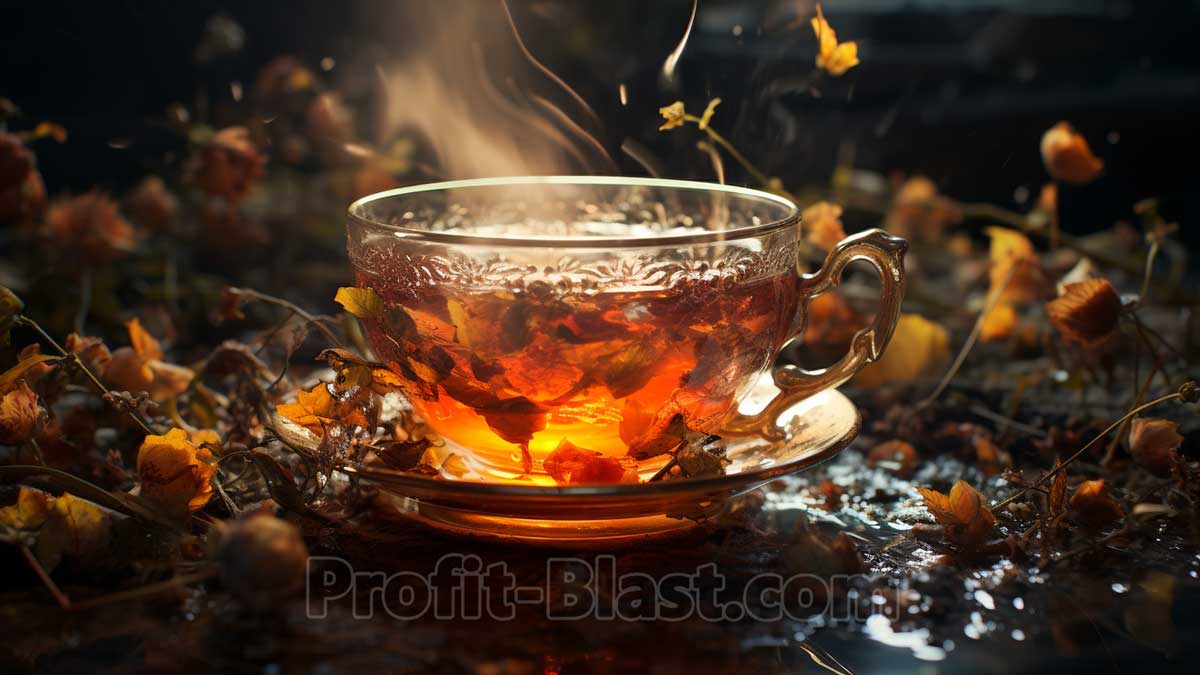How to Start a Tea Business and Sell Your Tea Online
– Updated October 27, 2023

Welcome to Profit-Blast, your Ultimate Blog for Passive Income and Earning Money from Home. In this Blog, we explain How to Start a Tea Business and How to Create Your Own Online Shop to Sell Tea Online. Let’s dive in.
Introduction
Tea, the second most widely consumed beverage in the world after water, holds immense potential as a business opportunity. Whether you’re a tea enthusiast or an aspiring entrepreneur, starting a tea business can be a rewarding venture.
With the rise of e-commerce, establishing an online tea store has become more accessible than ever before. This comprehensive guide will walk you through the essential steps and strategies to kickstart your tea business and create a flourishing online store.
Your Tea Business – Find a Unique Selling Proposition
Before delving into the logistics of starting a tea business, it’s crucial to identify your unique selling proposition (USP). A USP defines what sets your tea products apart from the competition, making them attractive to your target audience. Consider the following factors to develop a strong USP:
Determining Your Product Range
To begin, decide on the type of tea products you want to sell in your online store. Consider whether you want to focus on hot or cold beverages, flavored blends, or organic products. Reflect on your own preferences and passion for tea to guide your product selection.
Analyzing the Market
Thoroughly research existing tea brands to understand their success and identify gaps in the market. Study their packaging, product benefits, and target audience. Use this knowledge to create a unique tea product that caters to an unmet need or offers a distinctive value proposition.
Defining Your Purpose
Determine the purpose of your tea business. Do you want to emphasize flavor, health benefits, or sustainability? Align your product offerings with consumer desires and market trends. For example, if green tea is incredibly popular, consider developing a unique and high-quality green tea product to appeal to a wide audience.
Crafting Your Brand Identity
Choosing an impactful company name and logo is crucial to your tea business’s success. Your brand’s name and visual identity shape customers’ perceptions and help them remember your products. Aim for a name and logo that encapsulate the essence of your brand and leave a lasting impression.
Establishing Your Tea Business Entity

Now that you have a clear vision for your tea business, it’s time to establish it as a legal entity. Follow these steps to ensure compliance and set a solid foundation for your online store:
Registering Your Tea Business
Research the legal requirements for registering your tea business in your state or country. Depending on your location, you may need to register online, submit paper documents by mail, or complete the process in person. Registering your business as a legal entity is essential for tax purposes and protecting your personal assets.
Obtaining an Employer Identification Number (EIN)
Apply for an Employer Identification Number (EIN) with the Internal Revenue Service (IRS). An EIN is necessary for filing taxes and conducting business transactions. It’s a unique identifier that distinguishes your tea business from others.
Acquiring the Required Permits
Check with your local government to determine if you need any specific permits or licenses to operate an online tea business. Certain jurisdictions may require additional certifications or permissions, such as a Food Handler’s Permit or a Seller’s Permit.
Building Your Online Tea Store
To sell your tea products effectively online, you need to establish a professional and user-friendly online store. Designing a visually appealing and functional website is crucial to attracting and retaining customers. Here’s how you can set up your online store:
Choosing a Website Platform
Select a website platform that suits your needs and technical expertise. Two popular options for building e-commerce websites are Shopify and WordPress. Shopify offers an all-in-one solution specifically tailored to online stores, while WordPress provides more flexibility and customization options.
Designing Your Website
Create a clean and visually appealing website design that aligns with your brand identity. Choose basic fonts, optimize page loading speed, and ensure a seamless user experience. Consider using online platforms or hiring a professional web developer to help you design your website.
Setting Up Payment Processing
Integrate a secure and efficient payment processing system into your online store. Platforms like Shopify offer built-in payment gateways, allowing customers to make purchases using various methods, including credit cards, PayPal, or Apple Pay.
Adding Compelling Content
Enhance your website with engaging content that educates and entices customers. Consider creating a blog section where you can share tea-related articles, brewing tips, and industry insights. High-quality product photos and concise descriptions will help customers make informed purchasing decisions.
Identifying Your Target Market

Understanding your target market enables you to tailor your tea products and marketing efforts to their preferences. Conduct thorough market research to identify your ideal customers and their unique characteristics. Here are some strategies to define your target market:
Analyzing Competitors’ Customers
Research your competitors’ customer base to gain insights into their preferences and interests. Identify any underserved segments that you can target with your unique tea products. Differentiate your brand by filling a niche and offering superior value.
Defining Customer Demographics
Consider demographic factors such as age, gender, income level, and location to narrow down your target market. Analyze how these characteristics align with the benefits and features of your tea products. This information will guide your marketing strategies and product positioning.
Understanding Customer Psychographics
Go beyond demographics and delve into your target customers’ personality traits, values, and hobbies. Determine how your tea products align with their preferences and aspirations.
For example, if your potential customers value sustainability, incorporate eco-friendly packaging materials and highlight your commitment to environmental responsibility.
Developing Your Tea Product Line
With a clear understanding of your target market, it’s time to develop a product line that caters to their preferences. Consider the following approaches to offer a diverse and appealing selection of teas:
Flavored Teas and Blends
Create unique flavored blends by experimenting with tea flavors and complementary ingredients. Start with a base tea, such as green tea or black tea, and add fruits, flowers, spices, or herbs to enhance the flavor profile. You can either create blends on your own or work with a private label tea manufacturer to produce customized teas.
Single-Origin Teas
Offer single-origin teas that allow customers to experience the distinct flavors of teas from specific regions. Source high-quality teas from different parts of the world and educate your customers about the unique characteristics of each origin. Consider partnering with tea growers or wholesalers to access a wide range of single-origin teas.
Designing Eye-Catching Packaging

The packaging of your tea products plays a crucial role in attracting customers and creating a memorable brand image. Focus on designing packaging that stands out and effectively communicates your brand’s values. Consider the following tips for impactful packaging design:
Utilizing Color Psychology
Choose colors that evoke the desired emotions and associations in your target customers. For instance, use green to convey health and freshness, or incorporate gold elements for an elegant and premium feel. Experiment with different color combinations to find a design that resonates with your brand identity.
Incorporating Engaging Graphics
Integrate visually appealing artwork or graphics on your tea packaging to capture customers’ attention. Use images that convey movement or evoke positive emotions. Graphics should align with your brand story and create a strong visual identity for your tea products.
Showcasing Certifications and Awards
Highlight any relevant certifications or awards on your tea packaging to instill trust and convey your commitment to quality. Certifications such as USDA Organic Certification or Fair Trade Certification can differentiate your brand and attract customers who prioritize ethical and sustainable products.
Marketing Your Tea Products
Once your tea products and online store are ready, it’s time to promote your brand and generate interest among potential customers. Explore various marketing strategies to reach your target audience effectively:
Harnessing the Power of Social Media
Utilize social media platforms like Twitter, Facebook, and Instagram to connect with your audience. Engage with potential customers, share visually appealing photos of your teas, and tell the story of your brand. Build a community of tea enthusiasts and leverage social media to spread brand awareness.
Content Creation and Blogging
Create informative and engaging content related to tea on your website’s blog. Share brewing guides, health benefits of tea, and interesting tea facts to attract and educate your audience. Establish yourself as a trusted authority in the tea industry and drive traffic to your online store.
Collaborating with Influencers
Partner with influencers or tea enthusiasts who have a significant online following. Collaborate on content creation, product reviews, or giveaways to leverage their reach and tap into their audience. Influencer recommendations can greatly impact customer perception and drive sales.
Offline Marketing Opportunities
Don’t neglect offline marketing opportunities to complement your online presence. Participate in local farmers’ markets, host tea tastings or workshops, and distribute samples to generate buzz in your community.
Offline marketing can create personal connections and word-of-mouth referrals, contributing to your online store’s success.
The Benefits of Starting a Tea Business

Starting a tea business, especially an online store, offers several advantages that make it an appealing entrepreneurial venture. Consider the following benefits that come with running a tea business:
Unlimited Business Hours
With an online store, your tea business operates 24/7, allowing customers from around the world to browse and purchase your products at their convenience. This flexibility expands your potential customer base and boosts sales opportunities.
Lower Operation Costs
An online tea business eliminates the need for a physical retail space, reducing expenses associated with rent, utilities, and staffing. This cost-saving advantage allows you to allocate resources towards enhancing your products, branding, and marketing strategies.
Greater Flexibility and Independence
Running an online tea business provides you with the freedom to manage your operations from anywhere and set your own schedule.
Whether you prefer working from the comfort of your home or while traveling, an online store offers unparalleled flexibility and independence.
The Health Benefits of Tea
As you embark on your tea business journey, it’s essential to highlight the health benefits associated with tea consumption. Educate your customers about the positive impact tea can have on their well-being. Here are some notable health benefits of tea:
Promoting Overall Health
Numerous scientific studies suggest that tea consumption may help prevent various forms of cancer, improve cardiovascular health, and reduce the risk of stroke and heart disease. These health benefits make tea an attractive choice for health-conscious consumers.
Calorie-Free Refreshment
Tea, when consumed without additives like milk or sugar, is a calorie-free beverage. This makes it an excellent choice for individuals following weight loss or calorie-conscious diets. Tea provides a flavorful alternative to high-calorie drinks while quenching thirst.
Caffeine-Free Options
Herbal teas, such as chamomile or peppermint, offer caffeine-free alternatives to traditional teas. These caffeine-free options are ideal for individuals who are sensitive to caffeine or prefer a soothing beverage before bedtime.
Need Ideas to Start a Business?
Check Out these Amazing Home Income Ideas
Conclusion – How to Start a Tea Business
Starting a tea business and establishing an online store requires careful planning, a unique selling proposition, and effective marketing strategies. By following the steps outlined in this guide, you can confidently embark on your journey as a tea entrepreneur.
Remember to prioritize quality, differentiation, and customer satisfaction to build a successful and thriving tea business. Now that you have the knowledge and tools, it’s time to brew your entrepreneurial dreams into a reality.
Start your tea business today and create a brand that leaves a lasting impression in the world of tea enthusiasts.
Disclaimer: The information provided in this article is for informational purposes only and should not be considered financial advice. Always consult with a professional advisor before making any investment decisions.
This blog may contain affiliate links, which means that if you click on certain links and make a purchase, we may earn a commission. This commission comes at no additional cost to you, and it helps support the blog, allowing us to continue providing valuable content. Rest assured, we only recommend products or services that we genuinely believe in and have personally tested or researched. Thank you for your support!

0 Comments